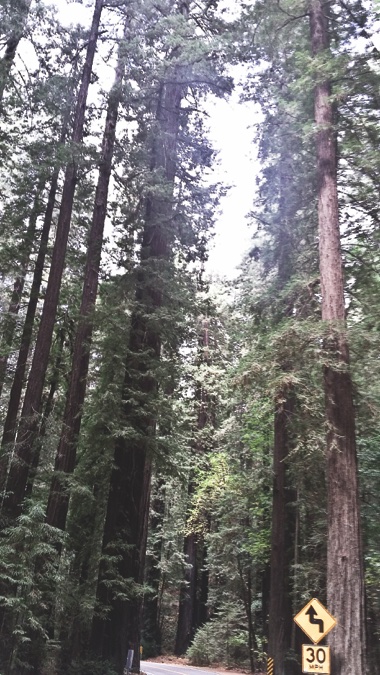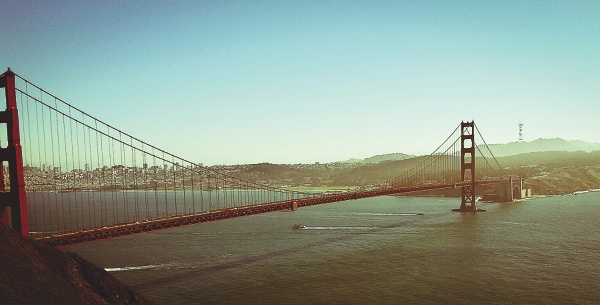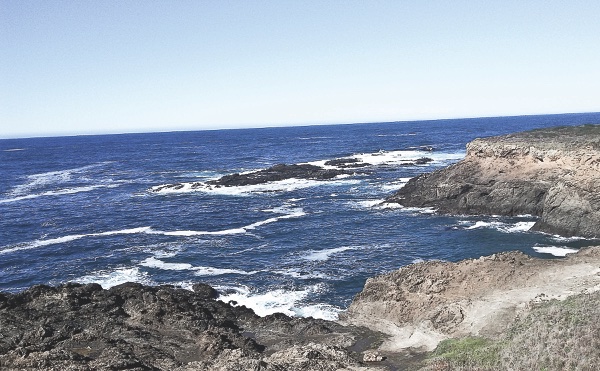If you ask any native, every day in California is sunny, even in the rain or the smog. Relatives beckoned and we said, yes, we will visit, but we will also spend time sightseeing, visiting Napa and Sonoma, and enjoying the spectacular views from Hwy 1.
“Great,” they responded. We’ll also picnic, hike the Redwoods, and dine near the beach in Eureka. Yes, Eureka, same as from the TV series. We have visited San Francisco and Napa several times in the past, but we wanted to visit a few new locations to the north. So our sojourn to Northern California begins; first stop Sonoma.

Avenue of the Giants twists and turns through Humboldt Redwoods State Park, home of the giant redwoods of California. (Photos provided)
Yes, we’re staying principally at B&Bs for the same reason as previously noted in our travels; great locations, great hosts, great guests, great information, great food, etc. We have learned more from visiting B&Bs than from any literature about the area and on this trip we were aided by the California Association of Boutique & Breakfast Inns or CABBI (www.cabbi.com). They are the only association representing B&Bs in California, so definitely your best bet for finding a great fit for your trip.
We’re off the plane and into the car heading for the Golden Gate Bridge when we hit our first obstacle – fog. We can’t see beyond the car in front of us, much less the bridge itself or the bay. Strangely, as soon as we exit the bridge and turn into Point Vista, the fog around us is gone! The bridge is still entrapped. You can’t see San Francisco at all, but we have clear sailing as we head further north.
Being hungry after the long flight, we stop at the most talked about hamburger joint in California: In-N-Out Burger. With a small menu and fast service, it was just what we needed. Now for a good night’s rest, as we will be tackling vineyards tomorrow.
From Sonoma we began a day of visiting wineries and enjoying great food, BUT weren’t exactly sure of the best way to attack that and still make it to day 2.
After a few wineries, all the tastings begin to take a toll and you will start looking for that designated driver. Enter the wine train which make stops up and down the valley, or wine tours from which there are several to choose. Some tours target the more popular wineries, others the lesser-known but equally higher end vintners. If you’ve not been to the region in the last few years, tour pricing has changed, so be sure to check the small print. Typically the price of a wine tour does NOT include the tasting fee. You may also be surprised at the tasting prices. Tastings can range from $10 to over $100 per winery depending upon the quality of wine being provided. Still not sure if we get to keep the glass or not! We decide to do it independently, hitting a few that we knew and wanted to learn more about but with coffee and food in between. We were also told that some hotels and B&Bs will included a pass for free tastings to a number of local wineries.

Many gems of the area are hidden, some difficult to find or in towns slightly off the beaten path so a little searching is warranted. This certainly applies to wineries, restaurants and B&Bs. With over 400 wineries in the Sonoma area and over 100 B&Bs, that’s a lot of searching, which means you will definitely need that glass of wine at the end of the day.
Our first gem was the Madrone Vineyards, previously Valley of the Moon Vineyard, in Glen Ellen, CA. We were met in the tasting room by Trevor Galts, Estate President who proceeded to give us a history of the 140-year-old vineyard, one of the oldest in California. It survived prohibition, pop wines and now produces a variety of quality wines. He explained how the Sonoma valley is blessed with its own deep aquifer thus avoiding the drought, the appellation distinction, grape variation due to the microclimates, soil qualities, the age of the vine itself and much more. Their more than 100-year-old Zinfandel vines are hand pruned to ensure each bunch of grapes receives the same amount of energy from the sun and from the vine itself thus imparting a unique flavor to the grapes – flavor envied by its’ younger cousins. Juice blending has become common to ensure just the right “taste.” To top it off, coopers, or craftsmen that make barrels, blend oak from different countries to make barrels that further enhance and modify the flavor of the wine. There’s a lot of science that goes into that glass of wine sitting in front of you!
Our plans that day changed at the last minute and we had to find new accommodations. The owner of one B&B recommended a competitor, think Macy’s at Christmas in Miracle on 34th Street, and the Vintage Towers Bed and Breakfast Inn, a 1901 Queen Ann Victorian, was able to provide a room at the last minute. The B&B was very unique in that a large portion of the menu was provided from its own garden. Not only did they have herbs and some fruit but also fresh eggs from a chicken coop in the back yard. The Vintage Towers has new owners, a mother and daughter team. The daughter recently completed culinary school and applies her expertise in the kitchen every morning, providing scrumptious and delicious meals.

As the sun began to rise the next morning, we could see the fog trying to make its way over the mountains to the west. The two were fighting for dominance and, fortunately, the sun won. We ended up with blue skies for a perfect day. Buoyed with a great breakfast, we headed north up Highway 101, through the Avenue of the Giants to Eureka.
The Avenue is basically old Highway 101. It intersects multiple Redwood groves, groves that contain some of the oldest trees and are part of the Humboldt Redwoods State Park. The road narrows with twists and turns as it passes through the thickets, sometimes with trees so close they become both the signposts and guardrails. A number of them show the scars of past encounters with vehicles. You’ll see many examples of some of the oldest trees on the earth.
Escaping the forests, we head into Eureka to the Cornelius Daly Inn, a colonial revival mansion built in 1905 (www.dalyinn.com). Immaculately updated and preserved with large rooms and windows, we had great views of the surrounding historical district. The four wood-burning fireplaces are supplemented with steam radiators, some uniquely curved to meet the shape of the room. The large garden area had several magnolia trees, one still in bloom as was a 10-foot Princess Plant covered with bright blue flowers. The area is also used for wedding receptions.
Founded in 1850, Eureka has played many roles in the western expansion of the US. It is the most western city in the 48 states, boasts the largest port between San Francisco and Portland, and played a leading role in the West Coast lumber trade. Today the entire city is a state historic landmark. Part II covers our route south, so stay tuned.




